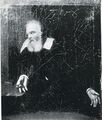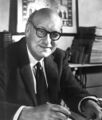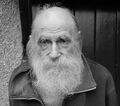Template:Selected anniversaries/August 25: Difference between revisions
No edit summary |
No edit summary |
||
| (9 intermediate revisions by the same user not shown) | |||
| Line 5: | Line 5: | ||
File:Galileo E pur si muove.jpg|link=Galileo Galilei (nonfiction)|1609: [[Galileo Galilei (nonfiction)|Galileo Galilei]] demonstrates his first telescope to Venetian lawmakers. | File:Galileo E pur si muove.jpg|link=Galileo Galilei (nonfiction)|1609: [[Galileo Galilei (nonfiction)|Galileo Galilei]] demonstrates his first telescope to Venetian lawmakers. | ||
File:Charles Camus - Cours de mathématique.jpg|link=Charles Étienne Louis Camus (nonfiction)|1699: Mathematician and mechanician [[Charles Étienne Louis Camus (nonfiction)|Charles Étienne Louis Camus]] born. He will be the author of ''Cours de mathématiques'' (Paris, 1766), along with a number of essays on mathematical and mechanical subjects. | File:Charles Camus - Cours de mathématique.jpg|link=Charles Étienne Louis Camus (nonfiction)|1699: Mathematician and mechanician [[Charles Étienne Louis Camus (nonfiction)|Charles Étienne Louis Camus]] born. He will be the author of ''Cours de mathématiques'' (Paris, 1766), along with a number of essays on mathematical and mechanical subjects. | ||
| Line 17: | Line 13: | ||
||1812: Nikolay Zinin born ... organic chemist. Pic: Extreme Moustache! | ||1812: Nikolay Zinin born ... organic chemist. Pic: Extreme Moustache! | ||
File:James Watt.jpg|link=James Watt (nonfiction)|1819: inventor, engineer, and chemist [[James Watt (nonfiction)|James Watt]] dies. He made major improvements to the steam engine. | File:James Watt.jpg|link=James Watt (nonfiction)|1819: inventor, engineer, and chemist [[James Watt (nonfiction)|James Watt]] dies. He made major improvements to the steam engine. | ||
| Line 53: | Line 47: | ||
||1917: Tosio Kato born ... mathematician who worked with partial differential equations, mathematical physics and functional analysis. Pic. | ||1917: Tosio Kato born ... mathematician who worked with partial differential equations, mathematical physics and functional analysis. Pic. | ||
||1917: Physicist and computer scientist Marcello Conversi born. Pic, Italian wiki: https://it.wikipedia.org/wiki/Marcello_Conversi | |||
||1921: Peter Cooper Hewitt dies ... electrical engineer who invented the mercury-vapour lamp, an important forerunner of fluorescent lamps. He studied the production of light using electrical discharges (while Thomas Edison was still developing incandescent filaments). The mercury-filled tubes he developed from the late 1890s, gave off an unattractive blue-green light. Although unsuitable in homes, its brilliance won wide adoption by photo studios because the black and white film of the time needed just bright light, despite its colour. There were many other industrial uses for the lamp. His manufacturing company (est. 1902) was bought by General Electric in 1919 which produced a new design in 1933. He took out his first eight mercury vapour lamp patents on 17 Sep 1901. Pic. | ||1921: Peter Cooper Hewitt dies ... electrical engineer who invented the mercury-vapour lamp, an important forerunner of fluorescent lamps. He studied the production of light using electrical discharges (while Thomas Edison was still developing incandescent filaments). The mercury-filled tubes he developed from the late 1890s, gave off an unattractive blue-green light. Although unsuitable in homes, its brilliance won wide adoption by photo studios because the black and white film of the time needed just bright light, despite its colour. There were many other industrial uses for the lamp. His manufacturing company (est. 1902) was bought by General Electric in 1919 which produced a new design in 1933. He took out his first eight mercury vapour lamp patents on 17 Sep 1901. Pic. | ||
||1929: The airship Graf Zeppelin passed over San Francisco's Golden Gate Bridge, headed for Los Angeles after a trans-Pacific voyage from Tokyo. Graf Zeppelin, built in 1928, had a trial flight on 18 Sep1928. It left on 11 Oct 1928 for its first transatlantic trip from Germany to Lakehurst, New Jersey, USA. After other flights, the Graf Zeppelin was again at Lakehurst ready to begin a trip around the world. It left there with 40 crew and 22 passengers on 8 Aug 1929, reaching Friedrichshafen, Germany on 10 Aug. After 5 days stopover, it set off for Tokyo, Japan, arriving there on 18 Aug, leaving again on 23 Aug headed for Los Angeles on 26 Aug. Next day it left for Lakehurst, NJ arriving there on 29 Aug 1929 after 12 days in the air.« | ||1929: The airship Graf Zeppelin passed over San Francisco's Golden Gate Bridge, headed for Los Angeles after a trans-Pacific voyage from Tokyo. Graf Zeppelin, built in 1928, had a trial flight on 18 Sep1928. It left on 11 Oct 1928 for its first transatlantic trip from Germany to Lakehurst, New Jersey, USA. After other flights, the Graf Zeppelin was again at Lakehurst ready to begin a trip around the world. It left there with 40 crew and 22 passengers on 8 Aug 1929, reaching Friedrichshafen, Germany on 10 Aug. After 5 days stopover, it set off for Tokyo, Japan, arriving there on 18 Aug, leaving again on 23 Aug headed for Los Angeles on 26 Aug. Next day it left for Lakehurst, NJ arriving there on 29 Aug 1929 after 12 days in the air.« | ||
File:Philo T Farnsworth.jpg|link=Philo Farnsworth (nonfiction)|1934: Inventor [[Philo Farnsworth (nonfiction)|Philo Farnsworth]] demonstrates his electronic television system to the public at the Franklin Institute in Philadelphia. | File:Philo T Farnsworth.jpg|link=Philo Farnsworth (nonfiction)|1934: Inventor [[Philo Farnsworth (nonfiction)|Philo Farnsworth]] demonstrates his electronic television system to the public at the Franklin Institute in Philadelphia. | ||
| Line 68: | Line 62: | ||
||1956: George Washington Pierce dies ... inventor who was a pioneer in radiotelephony and a noted teacher of communication engineering. He did work that led to the practical application of a variety of experimental discoveries in piezoelectricity and magnetostriction. He developed the Pierce oscillator, which utilizes quartz crystal to keep radio transmissions precisely on the assigned frequency and to provide similar accuracy for frequency meters. His other accomplishments include the mathematical calculation of the radiation properties of radio antennae; invention of the mercury-vapor discharge tube, which was the forerunner of the thyratron; invention of a method of recording sound on film; and sound generation by bats and insects. Pic: https://web2.ph.utexas.edu/utphysicshistory/GeorgeWPierce.html | ||1956: George Washington Pierce dies ... inventor who was a pioneer in radiotelephony and a noted teacher of communication engineering. He did work that led to the practical application of a variety of experimental discoveries in piezoelectricity and magnetostriction. He developed the Pierce oscillator, which utilizes quartz crystal to keep radio transmissions precisely on the assigned frequency and to provide similar accuracy for frequency meters. His other accomplishments include the mathematical calculation of the radiation properties of radio antennae; invention of the mercury-vapor discharge tube, which was the forerunner of the thyratron; invention of a method of recording sound on film; and sound generation by bats and insects. Pic: https://web2.ph.utexas.edu/utphysicshistory/GeorgeWPierce.html | ||
||1961: Morris William Travers dies ... chemist who, while working with Sir William Ramsay in London, discovered the element krypton (30 May 1898). The name derives from the Greek word for “hidden.” It was a fraction separated from liquified air, which when placed in a Plücker tube connected to an induction coil yielded a spectrum with a bright yellow line with a greener tint than the known helium line and a brilliant green line that corresponded to nothing seen before. Pic search | ||1961: Morris William Travers dies ... chemist who, while working with Sir William Ramsay in London, discovered the element krypton (30 May 1898). The name derives from the Greek word for “hidden.” It was a fraction separated from liquified air, which when placed in a Plücker tube connected to an induction coil yielded a spectrum with a bright yellow line with a greener tint than the known helium line and a brilliant green line that corresponded to nothing seen before. Pic search. | ||
||1965: Hedley Ralph Marston dies . | File:Hedley_Ralph_Marston.jpg|link=Hedley Marston (nonfiction)|1965: Biochemist [[Hedley Marston (nonfiction)|Hedley Ralph Marston]] dies. Marston's research into fallout from the British nuclear tests at Maralinga proved that significant radiation hazards existed at many of the Maralinga sites long after the tests. | ||
||1969: Harry Hammond Hess dies ... geologist who made the first comprehensive attempt at explaining the phenomenon of seafloor spreading (1960). This revived Alfred Wegener's earlier theory of continental drift. Together, these provided an interpretation of the earth's crust in terms of plate tectonics. The surface of the globe is not continuous. Rather, it is broken into a number of huge plates that float on the molten rock under the crust, moved over eons of geologic time by convective currents driven by earth's internal heat. With this motion these plates rub against, collide with, or separate from other plates. Thus the nature of earthquakes and volcanoes could be explained, plus the existence of ridges of young rock mapped around the globe under the ocean where the sea floor was spreading. Pic. | ||1969: Harry Hammond Hess dies ... geologist who made the first comprehensive attempt at explaining the phenomenon of seafloor spreading (1960). This revived Alfred Wegener's earlier theory of continental drift. Together, these provided an interpretation of the earth's crust in terms of plate tectonics. The surface of the globe is not continuous. Rather, it is broken into a number of huge plates that float on the molten rock under the crust, moved over eons of geologic time by convective currents driven by earth's internal heat. With this motion these plates rub against, collide with, or separate from other plates. Thus the nature of earthquakes and volcanoes could be explained, plus the existence of ridges of young rock mapped around the globe under the ocean where the sea floor was spreading. Pic. | ||
| Line 96: | Line 90: | ||
||2012: Neil Armstrong dies ... astronaut who was the first man to walk on the moon (20 Jul 1969, Apollo 11). He served as a Navy pilot during the Korean War, then joined the National Advisory Committee for Aeronautics (which became NASA), as a civilian test pilot. In 1962, he was the first civilian to enter the astronaut-training program. He gained experience as command pilot of the Gemini 8 mission, which accomplished the first physical joining of two orbiting spacecraft. Later he was commander of the Apollo 11 lunar mission. From 1971, he worked as professor of aerospace engineering at the University of Cincinnati. He was a member of the commission that investigated the 1986 Challenger space shuttle disaster. Pic. | ||2012: Neil Armstrong dies ... astronaut who was the first man to walk on the moon (20 Jul 1969, Apollo 11). He served as a Navy pilot during the Korean War, then joined the National Advisory Committee for Aeronautics (which became NASA), as a civilian test pilot. In 1962, he was the first civilian to enter the astronaut-training program. He gained experience as command pilot of the Gemini 8 mission, which accomplished the first physical joining of two orbiting spacecraft. Later he was commander of the Apollo 11 lunar mission. From 1971, he worked as professor of aerospace engineering at the University of Cincinnati. He was a member of the commission that investigated the 1986 Challenger space shuttle disaster. Pic. | ||
||2013: Akio Hattori dies ... mathematician working in algebraic topology who proved the Hattori–Stong theorem. No DOB. Pic search | ||2013: Akio Hattori dies ... mathematician working in algebraic topology who proved the Hattori–Stong theorem. No DOB. Pic search. | ||
File:George Spencer- | File:George Spencer-Brown.jpg|link=George Spencer-Brown (nonfiction)|2016: Polymath [[George Spencer-Brown (nonfiction)|George Spencer-Brown]] dies. Spencer-Brown wrote the unorthodox and influential ''Laws of Form'', calling it the "primary algebra" and the "calculus of indications". | ||
||2016: James Watson Cronin dies ... particle physicist. Pic. | |||
|| | ||2019: Computer scientist Sally Floyd dies. Floyd will contribute to computer networking, notably Internet congestion control. Pic search. | ||
</gallery> | </gallery> | ||
Latest revision as of 12:24, 7 February 2022
1609: Galileo Galilei demonstrates his first telescope to Venetian lawmakers.
1699: Mathematician and mechanician Charles Étienne Louis Camus born. He will be the author of Cours de mathématiques (Paris, 1766), along with a number of essays on mathematical and mechanical subjects.
1819: inventor, engineer, and chemist James Watt dies. He made major improvements to the steam engine.
1934: Inventor Philo Farnsworth demonstrates his electronic television system to the public at the Franklin Institute in Philadelphia.
1948: The House Un-American Activities Committee holds first-ever televised congressional hearing: "Confrontation Day" between Whittaker Chambers and Alger Hiss.
1965: Biochemist Hedley Ralph Marston dies. Marston's research into fallout from the British nuclear tests at Maralinga proved that significant radiation hazards existed at many of the Maralinga sites long after the tests.
2012: Voyager 1 crossed the heliopause to become the first spacecraft to enter interstellar space and study the interstellar medium.
2016: Polymath George Spencer-Brown dies. Spencer-Brown wrote the unorthodox and influential Laws of Form, calling it the "primary algebra" and the "calculus of indications".







